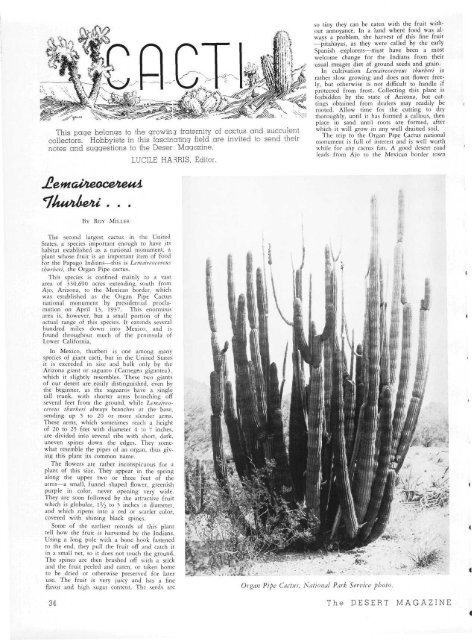the magazine y - Desert Magazine of the Southwest
the magazine y - Desert Magazine of the Southwest
the magazine y - Desert Magazine of the Southwest
Create successful ePaper yourself
Turn your PDF publications into a flip-book with our unique Google optimized e-Paper software.
This page belongs to <strong>the</strong> growing fraternity <strong>of</strong> cactus and succulent<br />
collectors. Hobbyists in this fascinating field are invited to send <strong>the</strong>ir<br />
notes and suggestions to <strong>the</strong> Deser: <strong>Magazine</strong>.<br />
LUCILE HARRIS, Editor.<br />
BY ROY MILLER<br />
The second largest cactus in <strong>the</strong> United<br />
States, a species important enough to have its<br />
habitat established as a national monument, a<br />
plant whose fruit is an important item <strong>of</strong> food<br />
for <strong>the</strong> Papago Indians—this is Lemaireocereus<br />
tburberi. <strong>the</strong> Organ Pipe cactus.<br />
This species is confined mainly to a vast<br />
area <strong>of</strong> 330,690 acres extending south from<br />
Ajo, Arizona, to <strong>the</strong> Mexican border, which<br />
was established as <strong>the</strong> Organ Pipe Cactus<br />
national monument by presidential proclamation<br />
on April 13, 1937. This enormous<br />
area is, however, but a small portion <strong>of</strong> <strong>the</strong><br />
actual range <strong>of</strong> this species. It extends several<br />
hundred miles down into Mexico, and is<br />
found throughout much <strong>of</strong> <strong>the</strong> peninsula <strong>of</strong><br />
Lower California.<br />
In Mexico, thurben is one among many<br />
species <strong>of</strong> giant cacti, but in <strong>the</strong> United States<br />
it is exceeded in size and bulk only by <strong>the</strong><br />
Arizona giant or saguaro (Carnegea gigantea),<br />
which it slightly resembles. These two giants<br />
<strong>of</strong> our desert are easily distinguished, even by<br />
<strong>the</strong> beginner, as <strong>the</strong> saguaros have a single<br />
tall trunk, with shorter arms branching <strong>of</strong>f<br />
several feet from <strong>the</strong> ground, while Lemaireocereus<br />
tburberi always branches at <strong>the</strong> base,<br />
sending up 5 to 20 or more slender arms.<br />
These arms, which sometimes reach a height<br />
<strong>of</strong> 20 to 25 feet with diameter 4 to 7 inches,<br />
are divided into several ribs with .short, dark,<br />
uneven spines down <strong>the</strong> edges. They somewhat<br />
resemble <strong>the</strong> pipes <strong>of</strong> an organ, thus giving<br />
this plant its common name.<br />
The flowers are ra<strong>the</strong>r inconspicuous for a<br />
plant <strong>of</strong> this size. They appear in <strong>the</strong> spring<br />
along <strong>the</strong> upper two or three feet <strong>of</strong> <strong>the</strong><br />
arms—a small, funnel shaped flower, greenish<br />
purple in color, never opening very wide.<br />
They are soon followed by <strong>the</strong> attractive fruit<br />
which is globular, iy2 to 3 inches in diameter,<br />
and which ripens into a red or scarlet color,<br />
covered with shining black spines.<br />
Some <strong>of</strong> <strong>the</strong> earliest records <strong>of</strong> this plant<br />
tell how <strong>the</strong> fruit is harvested by <strong>the</strong> Indians.<br />
Using a long pole with a bone hook fastened<br />
to <strong>the</strong> end, <strong>the</strong>y pull <strong>the</strong> fruit <strong>of</strong>f and catch it<br />
in a small net, so it does not touch <strong>the</strong> ground.<br />
The spines are <strong>the</strong>n brushed <strong>of</strong>f with a stick<br />
and <strong>the</strong> fruit peeled and eaten, or taken home<br />
to be dried or o<strong>the</strong>rwise preserved for later<br />
use. The fruit is very juicy and has a fine<br />
flavor and high sugar content. The seeds are<br />
34<br />
so tiny <strong>the</strong>y can be eaten with <strong>the</strong> fruit without<br />
annoyance. In a land where food was always<br />
a problem, <strong>the</strong> harvest <strong>of</strong> this fine fruit<br />
—pitahayas, as <strong>the</strong>y were called by <strong>the</strong> early<br />
Spanish explorers—must have been a most<br />
welcome change for <strong>the</strong> Indians from <strong>the</strong>ir<br />
usual meager diet <strong>of</strong> ground seeds and grain.<br />
In cultivation Lemaireocereus tburberi is<br />
ra<strong>the</strong>r slow growing and does not flower freely,<br />
but o<strong>the</strong>rwise is not difficult to handle if<br />
protected from frost. Collecting this plant is<br />
forbidden by <strong>the</strong> state <strong>of</strong> Arizona, but cuttings<br />
obtained from dealers may readily be<br />
rooted. Allow time for <strong>the</strong> cutting to dry<br />
thoroughly, until it has formed a callous, <strong>the</strong>n<br />
place in sand until roots are formed, after<br />
which it will grow in any well drained soil.<br />
The trip to <strong>the</strong> Organ Pipe Cactus national<br />
monument is full <strong>of</strong> interest and is well worth<br />
while for any cactus fan. A good desert road<br />
leads from Ajo to <strong>the</strong> Mexican border town<br />
Organ Pipe Cactus. National Park Service photo.<br />
The DESERT MAGAZINE

















